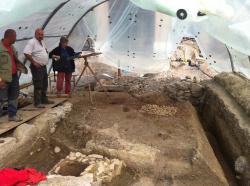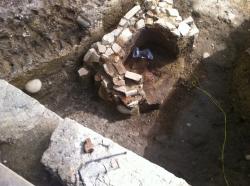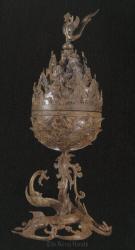INSTITUT SUPERIEUR D'ANTHROPOLOGIE
INSTITUTE OF ANTHROPOLOGY
ONLINE COURSES / COURS A DISTANCE
INSCRIPTION 2012 / Session III : Juillet 2012
REGISTRATION 2012 / Term III : July 2012
BULGARIE –  Vratsa - The archaeological season in the Bulgarian town of Vratsa has started for the summer, and was marked by the discovery of a child’s skeleton, preliminary dated at 8000 years BCE. It was found in the ruins of the shrine of the Sun God near the village of Ohoden. Archaeologists believe it was a human sacrifice. If this proves to be true, it would be the first such find in Bulgaria. The skeleton is from the Neolithic age and is the fifth in an ancient mausoleum, but unlike the other four, which are facing the direction of sunrise, it is facing the sunset. The scientists have made precise measurements of the positions of the bodies and these will be compared to the position of the sun in the autumn equinox. In an interview with public broadcaster Bulgarian National Television, archaeologist Georgi Ganetsovski said that analysis of the findings would provide valuable information on the life of the early inhabitants of Europe and data on the movement of the Sun. In previous archaeological seasons, discoveries at the site have included remains of dwellings, burial sites, human skeletons, horned skulls and other findings, suggesting that the area was a cult site for the Sun God. The archaeological dig of the Neolithic village near Ohoden will continue with 3D scanning of the ruins and artistic reconstruction of the dwellings. The site has already become a tourist attraction when, at the 2011 autumn equinox, spelt (a variety of wheat and a staple food in the diet of the Neolithic and Bronze Age peoples) was ritually sown. This summer it will be harvested in the manner of the age – with stone sickles. Tourists will also witness and participate in the construction of a Neolithic dwelling with stone tools typical for the period.
Vratsa - The archaeological season in the Bulgarian town of Vratsa has started for the summer, and was marked by the discovery of a child’s skeleton, preliminary dated at 8000 years BCE. It was found in the ruins of the shrine of the Sun God near the village of Ohoden. Archaeologists believe it was a human sacrifice. If this proves to be true, it would be the first such find in Bulgaria. The skeleton is from the Neolithic age and is the fifth in an ancient mausoleum, but unlike the other four, which are facing the direction of sunrise, it is facing the sunset. The scientists have made precise measurements of the positions of the bodies and these will be compared to the position of the sun in the autumn equinox. In an interview with public broadcaster Bulgarian National Television, archaeologist Georgi Ganetsovski said that analysis of the findings would provide valuable information on the life of the early inhabitants of Europe and data on the movement of the Sun. In previous archaeological seasons, discoveries at the site have included remains of dwellings, burial sites, human skeletons, horned skulls and other findings, suggesting that the area was a cult site for the Sun God. The archaeological dig of the Neolithic village near Ohoden will continue with 3D scanning of the ruins and artistic reconstruction of the dwellings. The site has already become a tourist attraction when, at the 2011 autumn equinox, spelt (a variety of wheat and a staple food in the diet of the Neolithic and Bronze Age peoples) was ritually sown. This summer it will be harvested in the manner of the age – with stone sickles. Tourists will also witness and participate in the construction of a Neolithic dwelling with stone tools typical for the period.
http://sofiaglobe.com/2012/06/25/archaeology-new-find-at-a-site-near-bulgarias-vratsa/#!prettyPhoto/0/
SUISSE – 
 Genève - Les céramiques ne trompent pas. Un four, datant de l'époque gallo-romaine, vient d'être déterré place Simon-Goulart, sur le chantier qui se trouve à quelques pas de la gare de Cornavin. Désormais, le service cantonal d'archéologie intervient sur le site pour effectuer les fouilles qui s'imposent. Comme le four qui a été déterré servait certainement à la métallurgie, il est plus que probable le reste du chantier réserve de nouvelles surprises.
Genève - Les céramiques ne trompent pas. Un four, datant de l'époque gallo-romaine, vient d'être déterré place Simon-Goulart, sur le chantier qui se trouve à quelques pas de la gare de Cornavin. Désormais, le service cantonal d'archéologie intervient sur le site pour effectuer les fouilles qui s'imposent. Comme le four qui a été déterré servait certainement à la métallurgie, il est plus que probable le reste du chantier réserve de nouvelles surprises.
http://www.tdg.ch/geneve/actu-genevoise/Un-four-galloromain-decouvert-sur-la-place-SimonGoulart/story/17843778
COREE DU SUD –  Buyeo - Most Koreans think of the wall paintings of Goguryeo tombs and the splendid gold crowns worn by the Silla royals when asked to name some of the most famous relics of Korea’s ancient three kingdoms period (B.C. 37 ― A.D. 668). Unlike the ones of Goguryeo (B.C. 37 ― A.D. 668) and Silla (B.C. 57 ― A.D. 935), relics of Baekje (B.C. 18 ― A.D. 660) are generally unknown to the public. For many, it’s hard to think of the iconic artifact of the ancient state ― which occupied today’s Chungcheong and Jeolla provinces. Yet archaeologist Im Hyo-jai, who serves as the president of the Society for East Asian Archaeology’s (SEAA) Korea office, says Baekje relics ― mostly found in Buyeo of South Chungcheong Province and Buan of North Jeolla Province ― are beginning to be considered important in the international archaeology community. The site in Buan is one of the only two ancient ritual sites in Asia, along with the one in Okinoshima Island in Japan’s Munakata region. Im said it is also important for archaeologists to cooperate with folklorists when studying the Baekje relics found in Buyeo and Buan. “What archaeologists study are the discovered relics, such as the broken pieces of jars that were used during the ancient divine rituals,” said Im. “We find out how old the relics are, and what they are made of. But it’s hard for us to find out how they were used in what cultural, social or spiritual context. And in order to find out the culture that produced these relics, we need to work with folklorists. For example, we can’t just say the ancient shamans held their rituals atop rocks and broke their jars as a spiritual gesture at the end of their ceremonies. We need to be able to explain the reasons behind these things.” Korea is planning to submit an official application for the Jungmak-dong site and its relics, along with other Baekje artifacts to be added on the UNESCO World Heritage List by the year 2016.
Buyeo - Most Koreans think of the wall paintings of Goguryeo tombs and the splendid gold crowns worn by the Silla royals when asked to name some of the most famous relics of Korea’s ancient three kingdoms period (B.C. 37 ― A.D. 668). Unlike the ones of Goguryeo (B.C. 37 ― A.D. 668) and Silla (B.C. 57 ― A.D. 935), relics of Baekje (B.C. 18 ― A.D. 660) are generally unknown to the public. For many, it’s hard to think of the iconic artifact of the ancient state ― which occupied today’s Chungcheong and Jeolla provinces. Yet archaeologist Im Hyo-jai, who serves as the president of the Society for East Asian Archaeology’s (SEAA) Korea office, says Baekje relics ― mostly found in Buyeo of South Chungcheong Province and Buan of North Jeolla Province ― are beginning to be considered important in the international archaeology community. The site in Buan is one of the only two ancient ritual sites in Asia, along with the one in Okinoshima Island in Japan’s Munakata region. Im said it is also important for archaeologists to cooperate with folklorists when studying the Baekje relics found in Buyeo and Buan. “What archaeologists study are the discovered relics, such as the broken pieces of jars that were used during the ancient divine rituals,” said Im. “We find out how old the relics are, and what they are made of. But it’s hard for us to find out how they were used in what cultural, social or spiritual context. And in order to find out the culture that produced these relics, we need to work with folklorists. For example, we can’t just say the ancient shamans held their rituals atop rocks and broke their jars as a spiritual gesture at the end of their ceremonies. We need to be able to explain the reasons behind these things.” Korea is planning to submit an official application for the Jungmak-dong site and its relics, along with other Baekje artifacts to be added on the UNESCO World Heritage List by the year 2016.
http://view.koreaherald.com/kh/view.php?ud=20120625000954&cpv=0
MYANMAR - Three historical sites will be upgraded to archaeological parks in collaboration with local companies, the Department of Archaeology, National Museum and Library under the Ministry of Culture said last week. The department announced that Inwa, a former royal capital in Tada Oo township in Mandalay Region, Pakangyi at Yesagyo in Magwe Region and Padalin Cave in Shan State’s Taunggyi township, would all be upgraded under the plan, which will see private companies invited to jointly undertake the preservation projects. The department lists 37 cultural sites as being of historical and archaeological value throughout the country. Last month, it announced that another five sites – Myaung Mya ancient city in Ayeyarwady Region; Myo Haung village in Launglon, Tanintharyi Region; and Wethali and Tharlarwati in Mrauk-U township and Danyawati in Kyauktaw township, Rakhine State – be listed as cultural sites.
http://www.mmtimes.com/2012/news/632/news63206.html
FRANCE –  Nîmes - Un point a été effectué sur l’imposant chantier de restauration de l’amphithéâtre mené au moins jusqu’en 2022. La travée 49 des arènes a fait l’objet d’une expérimentation exceptionnelle ces trois dernières années dans le cadre de la restauration de l’amphithéâtre suite à la constatation dès 2005 de dégradations, conséquences de l’usure du temps et notamment d’infiltrations d’eau. Le chantier a permis de mener des études archéologiques, mécanique et de restauration générale. La première, réalisée par l’Inrap et le CNRS , avait pour objectif d’affiner la connaissance de l’histoire du monument, son évolution bloc par bloc. Il fallait dénicher des témoignages de construction antique et des traces de l’occupation durant le Moyen âge. L’étude mécanique a, elle, porté sur les pierres des piliers en façade ainsi que les blocs de corniche qui ont montré un état de fracturation anormal. S’il y a bien sûr l’usure du temps, le problème vient aussi d’une moins bonne efficacité de l’écoulement des eaux à l’amphithéâtre. Les causes des dégradations ont été cernées grâce au travail du laboratoire de mécanique et génie civil de l’université de Montpellier II. Pour la restauration plus générale, les équipes ont surtout tenté de protéger de l’eau de ruissellement le monument, de consolider aussi les galeries, escaliers, gradins. le nettoyage de l’épiderme de la pierre a été effectué avec l’application de compresses qui ont ramolli la croûte noire, le tout étant complété par une projection de microfine de verre. La réparation de parties dégradées a pu être réalisée grâce à la greffe de pierres de Barutel et le ragréage avec un mortier reproduisant les caractéristiques de la pierre. Les vides dans la maçonnerie, détectés grâce à l’utilisation d’un radar, ont pu être comblés par l’injection de coulis de chaux. Tous ces travaux pourront être réitérés lors de la restauration des quatre autres travées.
Nîmes - Un point a été effectué sur l’imposant chantier de restauration de l’amphithéâtre mené au moins jusqu’en 2022. La travée 49 des arènes a fait l’objet d’une expérimentation exceptionnelle ces trois dernières années dans le cadre de la restauration de l’amphithéâtre suite à la constatation dès 2005 de dégradations, conséquences de l’usure du temps et notamment d’infiltrations d’eau. Le chantier a permis de mener des études archéologiques, mécanique et de restauration générale. La première, réalisée par l’Inrap et le CNRS , avait pour objectif d’affiner la connaissance de l’histoire du monument, son évolution bloc par bloc. Il fallait dénicher des témoignages de construction antique et des traces de l’occupation durant le Moyen âge. L’étude mécanique a, elle, porté sur les pierres des piliers en façade ainsi que les blocs de corniche qui ont montré un état de fracturation anormal. S’il y a bien sûr l’usure du temps, le problème vient aussi d’une moins bonne efficacité de l’écoulement des eaux à l’amphithéâtre. Les causes des dégradations ont été cernées grâce au travail du laboratoire de mécanique et génie civil de l’université de Montpellier II. Pour la restauration plus générale, les équipes ont surtout tenté de protéger de l’eau de ruissellement le monument, de consolider aussi les galeries, escaliers, gradins. le nettoyage de l’épiderme de la pierre a été effectué avec l’application de compresses qui ont ramolli la croûte noire, le tout étant complété par une projection de microfine de verre. La réparation de parties dégradées a pu être réalisée grâce à la greffe de pierres de Barutel et le ragréage avec un mortier reproduisant les caractéristiques de la pierre. Les vides dans la maçonnerie, détectés grâce à l’utilisation d’un radar, ont pu être comblés par l’injection de coulis de chaux. Tous ces travaux pourront être réitérés lors de la restauration des quatre autres travées.
http://www.midilibre.fr/2012/06/24/la-travee-49-restauree-et-etudiee-de-tres-pres,522413.php
FRANCE - Saint-Omer - Une quinzaine de personnes sont ainsi venues écouter Jean-Michel Willot, archéologue du Département, qui avait réalisé le diagnostic de fouilles sous le parking de l'Esplanade il y a un an. En se basant sur des plans du XVIe siècle, des tranchées avaient été ouvertes sous la chaussée comme autant de fenêtres sur les vestiges du passé. Cette campagne aura cependant été une « réussite moyenne » selon lui, n'apportant pas d'éléments véritablement nouveaux à la connaissance du château comtal édifié au Moyen Âge entre le cinéma et le parking. Les fouilles en milieu urbain sont toujours délicates car, au fil des siècles, on a détruit et reconstruit au même endroit ce qui, au final, a provoqué une élévation du « niveau de vie » de 2,5 m. Les fondations massives d'une des cinq tours du château ont pu être observées en partie. Des fragments de céramique et de cuir ont été retrouvés dans ce qui devait servir d'ancien dépotoir, tout comme un petit peigne en bois. « C'est plus surprenant de retrouver ce genre d'objet car le bois se dégrade rapidement. Mais comme on est ici dans une atmosphère très humide - on a même retrouvé la trace d'un ancien petit cours d'eau - cela explique son bon état de conservation ». Rien d'antérieur au XIe sicle n'a été trouvé dans ce secteur qui se situait hors des frontières de la ville originelle. Christine Cercy, archéologue de l'institut national de recherches archéologiques préventives (INRAP), a ensuite présenté les fouilles réalisées en 2007 au parc des ruines Saint-Bertin et celles réalisées en 2010 au coin de la rue Saint-Sépulcre à côté de la nouvelle mairie. Les premières intervenaient 150 ans après les dernières fouilles menées sur ce lieu qui avaient permis de mieux connaître l'abbaye démantelée. La campagne de l'INRAP s'est donc attachée à explorer le cloître en mal de renseignements. L'occasion de mettre à jour la cuisine du réfectoire, un bloc d'escalier... De belles pièces comme un tympan au dragon y ont été également découvertes. Elles sont actuellement visibles au musée Sandelin jusqu'à la fin du mois d'août. Tout comme celles découvertes dans le chantier à côté de la nouvelle mairie. Des verres et un bel objet servant à servir de l'eau ont été trouvés dans les latrines d'une ancienne habitation. Deux grandes caves médiévales ont aussi été explorées, qui témoignent du niveau de vie élevé des occupants de l'époque.
http://www.lavoixdunord.fr/region/une-conference-pour-tout-savoir-de-ces-curieuses-fouilles-jna37b0n538407